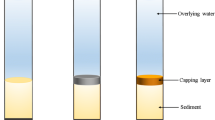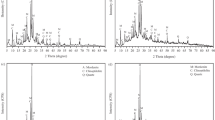Abstract
Purpose
Ferrihydrite (Fh) and calcite were used as reactive capping layers for a eutrophic lake. The effectiveness of Fh and/or calcite capping for demobilizing phosphorus (P) in the sediment from the overlying water was tested, and the responses of carbon (C), nitrogen (N), and iron (Fe) to different capping treatments were analyzed as well.
Materials and methods
Twelve sediment cores were collected randomly using polycarbonate tubes from Ornamental Lake in the Royal Botanic Gardens of Melbourne, Australia. Four groups with three replicates were separated randomly and labeled as the control (no capping), calcite (capped with 1-cm-deep calcite), Fh (capped with 1-cm-deep synthesized Fh powder), and calcite + Fh (CaFh, capped with 0.5-cm-deep Fh powder first and then with 0.5-cm-deep calcite). Gentle bubbling was employed to prevent anoxic conditions in the sediments and stimulate vascular plant ventilation during a 15-day static incubation. The overlying water sample mixed by a small magnetic stirrer was withdrawn 1, 3, 7, 11, and 15 days after capping for the analyses of filterable reactive phosphorus (FRP), filterable N, and Fe species.
Results and discussion
The results showed that CaFh had a greater effect on the FRP removal in the overlying water than Fh alone. No significant Fe release was observed for Fh and CaFh compared to the control and calcite. The introduction of Fh increased the release of ammonium and total N. After incubation, no significant differences were observed among total P, total N, and organic carbon in the upper sediments, except for total Fe.
Conclusions
Composite capping with Fh and calcite could be used as an effective, low-cost natural method to block the release of P from the sediment without a significant Fe pollution risk. The potential environmental risks need further attention.






Similar content being viewed by others
References
Akhurst D, Jones GB, McConchie DM (2004) The application of sediment capping agents on phosphorus speciation and mobility in a sub-tropical dunal lake. Mar Freshwat Res 2004:715–725
Antelo J, Fiol S, Pérez C, Mariño S, Arce F, Gondar D, López R (2010) Analysis of phosphate adsorption onto ferrihydrite using the CD-MUSIC model. J Colloid Interf Sci 347(1):112–119. https://doi.org/10.1016/j.jcis.2010.03.020
Berg U, Neumann T, Donnert D, Nüesch R, Stüben D (2004) Sediment capping in eutrophic lakes-efficiency of undisturbed calcite barriers to immobilize phosphorus. Appl Geochem 19:1759–1771, 11. https://doi.org/10.1016/j.apgeochem.2004.05.004
Beutel MC (2006) Inhibition of ammonia release from anoxic profundal sediments in lakes using hypolymnetic oxygenation. Ecol Eng 28:271–279, 3. https://doi.org/10.1016/j.ecoleng.2006.05.009
Chen L, Zheng T, Zhang J, Liu J, Zheng X (2014) Effective control of modified palygorskite to NH4 +-N release from sediment. Environ Technol 35:60–69, 1. https://doi.org/10.1080/09593330.2013.808268
Colme TD (2003) Long-distance transport of gases in plants: a perspective on internal aeration and radial oxygen loss from roots. Plant Cell Environ 26:17–36, 1. https://doi.org/10.1046/j.1365-3040.2003.00846.x
Cooke CD, Welch EB, Stanley SP, Nichols A (2005) Restoration and management of lakes and reservoirs, 3rd edn. CRC Press, Boca Raton
Cornelissen G, Schaanning M, Gunnarsson JS, Eek E (2016) A large-scale field trial of thin-layer capping of PCDD/F-contaminated sediments: sediment-to-water fluxes up to 5 years post-amendment. Integ Environ Asses Manag 12:216–221, 2. https://doi.org/10.1002/ieam.1665
Cornell RM, Schwertmann U (2003) The iron oxides: structure, properties, reactions, occurrences and uses. Wiley-VCH, New York. https://doi.org/10.1002/3527602097
Edgar FL, Keenan LW (1997) Managing phosphorus-based, cultural eutrophication in wetlands: a conceptual approach. Ecol Eng 9:109–118
Förstner U, Apitz SE (2007) Sediment remediation: US focus on capping and monitored natural recovery Fourth International Battelle Conference on Remediation of Contaminated Sediments. J Soils Sediments 7:351–358, 6. https://doi.org/10.1065/jss2007.10.256
Ghosh U, Luthy RG, Cornelissen G, Werner D, Menzie CA (2011) In-situ sorbent amendments: a new direction in contaminated sediment management. Environ Sci Technol 45:1163–1168, 4. https://doi.org/10.1021/es102694h
Grace MR, Scicluna TR, Vithana CL, Symes P, Lansdown KP (2010) Biogeochemistry and cyanobacterial blooms: investigating the relationship in a shallow, polymictic, temperate lake. Environ Chem 7:443–456, 5. https://doi.org/10.1071/EN10042
Hart BT, Roberts S, James R, O’Donohue M, Tayor J, Donnert D, Furrer R (2003) Active barriers to reduce phosphorus release from sediments: effectiveness of three forms of CaCO3. Aust J Chem 56:207–217, 3. https://doi.org/10.1071/CH02232
Huang HM, Xiao XM, Yan B, Yang LP (2010) Ammonium removal from aqueous solutions by using natural Chinese (Chende) zeolite as adsorbent. J Hazard Mater 175:247–252, 1-3. https://doi.org/10.1016/j.jhazmat.2009.09.156
Jacobs PH, Waite T (2004) The role of aqueous iron(II) and manganese(II) in sub-aqueous active barrier systems containing natural clinoptilolite. Chemosphere 54:313–324, 3. https://doi.org/10.1016/S0045-6535(03)00751-3
Jacobs PH, Förstner U (1999) Concept of sub aqueous capping of contaminated sediments with active barrier systems (ABS) using natural and modified zeolites. Water Res 33:2083–2087, 9. https://doi.org/10.1016/S0043-1354(98)00432-1
Jambor JL, Dutrizac JE (1998) Occurrence and constitution of natural and synthetic ferrihydrite, a widespread iron oxyhydroxide. Chemical Rev 98:2549–2585, 7. https://doi.org/10.1021/cr970105t
Kang SK, Choo KW, Lim KH (2003) Use of iron oxide particles as adsorbents to enhance phosphorus removal from secondary wastewater effluent. Sep Sci Technol 38:3853–3874, 15. https://doi.org/10.1081/SS-120024236
Kleeberg A, Herzog C, Hupfer M (2013) Redox sensitivity of iron in phosphorus binding does not impede lake restoration. Water Res 47:1491–1502, 3. https://doi.org/10.1016/j.watres.2012.12.014
Knox AS, Kaplan DI, Paller MH (2006) Phosphate sources and their suitability for remediation of contaminated soils. Sci Total Environ 357:271–279, 1-3. https://doi.org/10.1016/j.scitotenv.2005.07.014
Knox AS, Paller MH, Roberts J (2012) Active capping technology—new approaches for in situ remediation of contaminated sediments. Remediat J 22:93–117, 2. https://doi.org/10.1002/rem.21313
Koschel R, Benndorf J, Proft G, Recknagel F (1983) Calcite precipitation as a natural control mechanism of eutrophication. Archives Hydrobiol 98:380–408
Lin J, Zhan Y, Zhu Z (2011) Evaluation of sediment capping with active barrier systems (ABS) using calcite/zeolite mixtures to simultaneously manage phosphorus and ammonium release. Sci Total Environ 409:638–646, 3. https://doi.org/10.1016/j.scitotenv.2010.10.031
Lovley DR, Phillips EJP (1986) Organic matter mineralization with reduction of ferric iron in anaerobic sediments. Appl Environ Microbiol 51:683–689 4
Mao Y, Pham AN, Xin Y, Waite DT (2012) Effects of pH, floc age and organic compounds on the removal of phosphate by pre-polymerized hydrous ferric oxides. Sep Purif Technol 91:38–45. https://doi.org/10.1016/j.seppur.2011.09.045
Megonigal JP, Hines ME, Visscher PT (2004) Anaerobic metabolism: linkages to trace gases and aerobic processes. In: Schlesinger WH (ed) Biogeochemistry. Elsevier-Pergamon, Oxford
Mort HP, Slomp CP, Gustafsson BG, Andersen TJ (2010) Phosphorus recycling and burial in Baltic Sea sediments with contrasting redox conditions. Geochim Cosmochi Acta 74:1350–1362, 4. https://doi.org/10.1016/j.gca.2009.11.016
Ndungu K, Schaanning M, Braaten HFV (2016) Effects of organic matter addition on methylmercury formation in capped and uncapped marine sediments. Water Res 103:401–407. https://doi.org/10.1016/j.watres.2016.07.055
Paller MH, Knox AS (2010) Amendments for the remediation of contaminated sediments: evaluation of potential environmental impacts. Sci Total Environ 408:4894–4900, 20. https://doi.org/10.1016/j.scitotenv.2010.06.055
Peretyazhko TS, Zachara JM, Kennedy DW, Fredrickson JK, Arey BW, McKinley JP, Wang CM, Dohnalkova AC, Xia Y (2010) Ferrous phosphate surface precipitates resulting from the reduction of intragrain 6-line ferrihydrite by Shewanella oneidensis MR-1. Geochim Cosmochi Acta 74:3751–3767, 13. https://doi.org/10.1016/j.gca.2010.04.008
Qualls RG, Sherwood LJ, Richardson CJ (2009) Effect of natural dissolved organic carbon on phosphate removal by ferric chloride and aluminum sulfate treatment of wetland waters. Water Resour Res 45:W09414 9
Ramírez-Pérez AM, de Blas E (2017) Iron reactivity in anoxic sediments in the Ría de Vigo (NW Spain). Chemosphere 174:8–19. https://doi.org/10.1016/j.chemosphere.2017.01.097
Reddy KR, Kadlec RH, Flaig E, Gale PM (1999) Phosphorus retention in streams and wetlands—a review. Crit Rev Environ Sci Technol 29:86–146
Reddy KR, DeLaune R (2008) Biogeochemistry of wetlands: science and applications. CRC Press, Boca Raton. https://doi.org/10.1201/9780203491454
Rentz JA, Turner IP, Ullman JL (2009) Removal of phosphorus from solution using biogenic iron oxides. Water Res 43:2029–2035, 7. https://doi.org/10.1016/j.watres.2009.02.021
Roberts KL, Kessler AJ, Grace MR, Cook PLM (2014) Increased rates of dissimilatory nitrate reduction to ammonium (DNRA) under oxic conditions in a periodically hypoxic estuary. Geochi Cosmochi Acta 133:313–324. https://doi.org/10.1016/j.gca.2014.02.042
Roden EE, Wetzel RG (2002) Kinetics of microbial Fe(III) oxide reduction in freshwater wetland sediments. Limnol Oceanogr 47:198–211, 1. https://doi.org/10.4319/lo.2002.47.1.0198
Sherwood LJ, Qualls R (2001) Stability of phosphorus within a wetland soil following ferric chloride treatment to control eutrophication. Environ Sci Technol 35:4126–4131, 20. https://doi.org/10.1021/es0106366
Smolders AJP, Lamers LPM, Moonen M, Zwaga K, Roelofs JGM (2001) Controlling phosphate release from phosphate-enriched sediments by adding various iron compounds. Biogeochemistry 54:219–228, 2. https://doi.org/10.1023/A:1010660401527
Takahashi H, Yamauchi T, Colmer TD, Nakazono M (2014) Aerenchyma formation in plants. Plant Cell Monogr 21:247–265. https://doi.org/10.1007/978-3-7091-1254-0_13
Wen DH, Ho YS, Tang XY (2006) Comparative sorption kinetic studies of ammonium onto zeolite. J Hazard Mater 133:252–256
Wolthoorn A, Temminghoff EJM, Van Riemsdijk WH (2004) Effect of synthetic iron colloids on the microbiological NH4 + removal process during groundwater purification. Water Res 38:1884–1892, 7. https://doi.org/10.1016/j.watres.2003.12.026
Yang Y, Takizawa S, Sakai H, Murakami M, Watanabe N (2012) Removal of organic matter and phosphate using ferrihydrite for reduction of microbial regrowth potential. Water Sci Technol 66:1348–1353, 6. https://doi.org/10.2166/wst.2012.334
Yin H, Du Y, Kong M, Liu C (2017a) Interactions of riverine suspended particulate matter with phosphorus inactivation agents across sediment-water interface and the implications for eutrophic lake restoration. Chem Eng J 327:150–161. https://doi.org/10.1016/j.cej.2017.06.099
Yin H, Kong M (2015) Reduction of sediment internal P-loading from eutrophic lakes using thermally modified calcium-rich attapulgite-based thin-layer cap. J Environ Manag 151:178–185. https://doi.org/10.1016/j.jenvman.2015.01.003
Yin H, Kong M, Fan C (2013) Batch investigations on P immobilization from wastewaters and sediment using natural calcium rich sepiolite as a reactive material. Water Res 47:4247–4258, 13. https://doi.org/10.1016/j.watres.2013.04.044
Yin H, Yan X, Gu X (2017b) Evaluation of thermally-modified calcium-rich attapulgite as a low-cost substrate for rapid phosphorus removal in constructed wetlands. Water Res 115:329–338. https://doi.org/10.1016/j.watres.2017.03.014
Zamparas M, Zacharias I (2014) Restoration of eutrophic freshwater by managing internal nutrient loads: a review. Sci Total Environ 496:551–562. https://doi.org/10.1016/j.scitotenv.2014.07.076
Zou Y, Grace MR, Roberts KL, Yu X (2017) Thin ferrihydrite sediment capping sequestrates phosphorus experiencing redox conditions in a shallow temperate lacustrine wetland. Chemosphere 185:673–680. https://doi.org/10.1016/j.chemosphere.2017.07.052
Acknowledgments
We would like to express our gratitude to Peter Symes and Steven Liu of RBG for their help during field sampling and Keralee Browne, Weiwen Wong, Tina Hines, and Keryn Roberts of the Water Studies Centre for their help during chemical analyses. We are also grateful to the editor and two reviewers for their dedicated work in enhancing the quality of this paper.
Funding
This research was supported by the National Key Research and Development Program of China (2016YFC0500408), the National Natural Science Foundation of China (41471079, 41271107), and the Northeast Institute of Geography and Agroecology, CAS (IGA-135-05).
Author information
Authors and Affiliations
Corresponding author
Additional information
Responsible editor: Haihan Zhang
Rights and permissions
About this article
Cite this article
Yu, X., Grace, M.R., Sun, G. et al. Application of ferrihydrite and calcite as composite sediment capping materials in a eutrophic lake. J Soils Sediments 18, 1185–1193 (2018). https://doi.org/10.1007/s11368-017-1872-4
Received:
Accepted:
Published:
Issue Date:
DOI: https://doi.org/10.1007/s11368-017-1872-4




